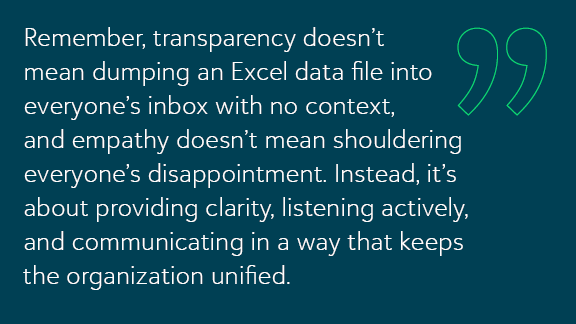How to Navigate Tricky End-of-Year Budget Conversations

You don your cape every morning when you step into the finance office. As a nonprofit CFO or finance lead, you’re not just balancing numbers—you’re protecting your organization’s mission from the twin villains of scarcity and misunderstanding. When tough budget debates erupt, it’s your heroic clarity and steady hand that keep the team focused on impact, not blame.
Staying calm isn’t always easy, especially when your funding forecasts look a little like Swiss cheese and you are trying to evaluate three new revenue channels. Here are a few tips to manage these tricky budget decisions and conversations effectively for you and your organizations.
Why Tough Budget Talks Matter
On the face of it, nonprofit budgeting should just be about balancing revenues and expenses. But it’s not. You’re juggling mission dreams, donor intentions, restricted grants, and a little wishful thinking. Somewhere in all that is a spreadsheet or two you can actually trust (to keep with the superhero analogy, this is your cape).
Unlike the corporate world, where the answer is often “grow profits,” the nonprofit sector’s aim is maximizing impact for every single dollar—whether it comes from an annual gala, a government grant, or the mysterious generosity of a recurring donor who signs their checks, “A Friend” (don’t we all wish we had those friends?).
Understanding these unique pressures is your first heroic step. Nonprofit budgeting is inherently complex and emotionally charged because it’s not just about numbers—it’s about impact. Every line item feels personal, whether it’s a beloved program, someone’s job, or a vital community service.
The tension intensifies when solutions aren’t easy. Maybe a grant isn’t renewed, operating costs spike, or a major funder suddenly goes silent. All eyes turn to Finance—yes, that’s you—hoping you’ll conjure more dollars by sheer force of accounting. More often than not, Finance is the one holding up the raincloud, responsible for delivering those tough conversations.
The Not-So-Secret Sauce: Transparency and Empathy
Here’s your superpower: you can turn “finance dread” into “finance trust.” How? By leading with transparency and empathy. Traditionally, these aren’t traits associated with Finance and Accounting.
- Transparency means openly sharing the facts, the good, the bad, and the ugly, with your colleagues, leadership, and community.
- Empathy means understanding the emotions swirling beneath the surface, especially when you have to say “no” or “not this year.”
When these two forces unite, budget conversations shift from battlegrounds to brainstorming sessions. Remember, transparency doesn’t mean dumping an Excel data file into everyone’s inbox with no context, and empathy doesn’t mean shouldering everyone’s disappointment. Instead, it’s about providing clarity, listening actively, and communicating in a way that keeps the organization unified. It’s a complicated line to walk but one that’s critical to nonprofit success.

Practical Prep: Stack the Deck in Your Favor
Before you face the villains of doubt and defensiveness that often arise during difficult conversations, arm yourself with actionable intel and heroic poise.
Know Your Story
Gather key metrics alongside the human tales behind them. Highlight past budget pivots that saved the day and explain current constraints—rising rent, delayed grants, or unexpected program expenses.
Anticipate Questions
Picture the concerns of program managers, executive leaders, and external partners. What questions are they likely to have? Prepare concise, honest answers and practice translating jargon into everyday language so no one feels locked out of the conversation.
Lead with Listening
Open the dialogue by inviting feedback: “What worries you most about this quarter?” When program staff defend their budgets, they reveal frontline insights you can’t get from numbers alone.
By doing this groundwork, you shift the narrative from “here’s bad news” to “let’s conquer these challenges together.”
Storytelling: Bringing Spreadsheets to Life
Facts inform, but stories inspire. Weave narratives into your budget talk.
- Share real-world examples: “When our youth-mentoring program lost its grant last year, volunteers rallied to fundraise $2,000 in two weeks and redesigned their outreach.”
- Tie line items to tangible outcomes: “That $500 for office supplies covered printing for 150 workshop participants.”
- Paint a compelling vision for future possibilities: “With an extra $10,000, we could hire a part-time coordinator to double our enrollment.”
Adding these qualitative measures to the lines in your report adds important context and showcases that you recognize the value behind each expense. You can also highlight what items were one-time expenses and which ones are on-going.
Empathetic Framing: From “Can’t” to “Can”
Let’s address the elephant in the boardroom: nobody likes hearing, “We can’t afford that right now.” But what if there’s a better way to frame this news?
Empathetic framing starts by acknowledging disappointment—“I know this is frustrating”—then guiding everyone toward shared solutions. Validate emotions, focus on the big picture, and invite creative thinking. This approach not only feels better but often leads to stronger outcomes, because teams rally together rather than retreat into defensive us vs. them postures. Empathy is a core leadership quality in finance. By showing you understand the hopes behind each request, you foster genuine partnership and soften hard news.
The Art of Delivering Tough News
How you deliver the update is as heroic as the facts themselves.
Stay Mission-Focused
Center every message on impact: this isn’t penny-pinching. It’s stewarding resources to maximize community outcomes.
Recognize the Human Toll
Acknowledge that budget shifts have real consequences for staff, volunteers, and clients. A simple, “We know this affects your team’s plans,” carries more weight than figures alone.
Chart the Course Forward
Never end on a cliffhanger. Offer clear next steps whether brainstorming cost-saving tactics, scheduling a funding-prospect review, or setting quarterly priorities.
Empathy + Data = Trust
Here’s the ultimate hero formula: lead with empathy, back it up with crisp data, and keep the dialogue open. By validating hopes and frustrations, presenting concise numbers, and inviting questions, you transform finance from gatekeeper to trusted ally. It’s this blend of heart and rigor that forges resilience and unity, even when dollars are tight.
Next time someone asks, “Do you have a minute to talk budget?”, smile, tighten your cape, and step into the spotlight. With empathy in your words and data in your toolkit, you’ll guide your team through any financial storm, emerging stronger on the other side.
To learn more about budgeting when you don’t have a clear view of the future, check out the webinar, Budgeting into Uncertainty: Navigating Year-End with Clarity and Courage, part of the Ultimate CFO Series with Andrew Horrow.



